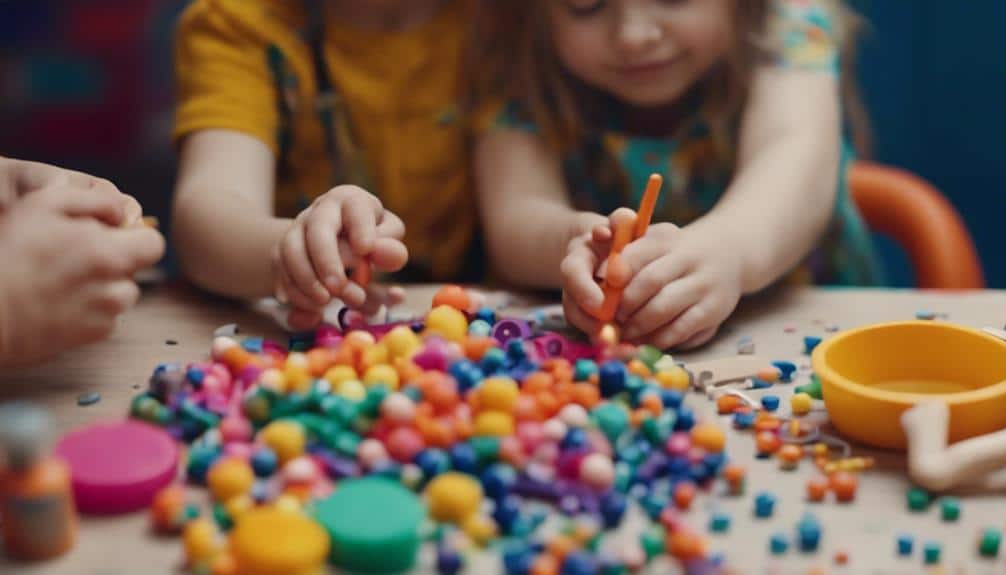Developing effective fine motor skills in children is imperative for their successful engagement in daily activities and academic tasks. ‘7 Effective Pediatric Therapy Techniques for Fine Motor Skills’ introduces a comprehensive suite of strategies to enhance these crucial skills through innovative and child-friendly activities. From improving hand-eye coordination to strengthening finger muscles, these techniques are designed to offer therapeutic benefits playfully. However, the real intrigue lies in understanding how each activity contributes explicitly to developmental milestones and the underlying principles that make these techniques effective and essential. Let us explore how integrating these practices can significantly impact a child’s fine motor skill development.
Key Takeaways
- Sensory integration tools enhance fine motor skills through tactile and visual activities.
- Weighted therapy equipment supports self-regulation, improving focus and fine motor control.
- Precision exercises like using pegboards boost hand coordination and spatial awareness.
- Therapeutic putty and CanDo Theraputty are effective for hand and finger strengthening.
Tummy Time Enhancements
Tummy time, a foundational activity for infant development, strengthens shoulder stability and hand arch formation and significantly enhances fine motor skills crucial for early childhood milestones. Recognizing the importance of these developmental stages, incorporating varied activities during tummy time can foster an enriching environment for infants. Activities such as tunnel and scooter board play are enjoyable and instrumental in enhancing fine motor skills. These activities encourage infants to explore movement, supporting the development of coordination and balance necessary for future tasks like writing and throwing.
Moreover, introducing Abilitations Sensory Floor Tiles during tummy time adds a sensory-rich element, captivating infants’ attention while they engage their muscles and minds. This innovative approach to tummy time not only aids in physical development but also sensory integration, providing a multifaceted benefit to fine motor skill development. By integrating these practices into tummy time routines, parents and caregivers can provide a supportive and stimulating environment that nurtures the building blocks of fine motor precision, ensuring a solid foundation for the myriad of developmental milestones ahead.
Vertical Surface Activities
Building on the foundational skills nurtured during tummy time, engaging children in vertical surface activities offers numerous benefits for their fine motor skill development. Incorporating tasks such as painting or writing on wall-mounted whiteboards and easels strengthens neck and shoulder muscles and enhances hand-eye coordination and precision required for tasks like writing. This segment will explore practical ways to implement these wall-based activities, aiming to foster a more focused and skillful approach to fine motor development in children.
Benefits of Vertical Surfaces
Engaging in vertical surface activities, such as painting on easels and writing on wall-mounted whiteboards, is crucial in enhancing children’s fine motor skills, including shoulder stability and hand arch development. These motor skills activities leverage the foundational elements introduced during tummy time, further promoting neck and shoulder muscle strength. Utilizing vertical surfaces supports children in refining their visual tracking skills and precision in executing delicate motor tasks.
This unique approach fosters stability and focus and holistically nurtures the development of fine motor skills. By incorporating vertical surface activities, children have an enriching environment that bolsters their motor skills through play and exploration, embodying a practical and empathetic approach to pediatric therapy.
Implementing Wall-Based Tasks
Implementing wall-based tasks into a child’s daily routine offers a practical and engaging method to strengthen their fine motor skills and enhance physical stability. These activities, integral to occupational therapy, leverage vertical surface activities to improve fine motor control, visual motor skills, and hand-eye coordination. Children actively develop their shoulder muscles by focusing on tasks like painting on easels or writing on vertical surfaces, which are crucial for stability.
| Activity | Skills Enhanced | Tools Required |
|---|---|---|
| Painting on Easels | Fine Motor Control, Shoulder Stability | Easel, Paints |
| Writing on Walls | Visual-motor integration, Fine Motor Skills | Wall-mounted Whiteboards, Markers |
| Sticker Placing | Hand-Eye Coordination, Precision | Stickers, Posters |
| Vertical Puzzles | Fine Motor Skills, problem-solving | Puzzle Pieces, Vertical Boards |
| Tracing Shapes | Visual Tracking, Hand-Eye Coordination | Tracing Paper, Markers |
These tasks promote essential skills for developmental progress and foster a sense of belonging and accomplishment among young learners.
Hand and Finger Strengthening

Focusing on hand and finger strengthening exercises, such as therapeutic putty, is a proven and practical approach to enhancing fine motor skills in children. Strengthening the intrinsic hand muscles is crucial in developing fine motor skills for daily tasks and academic activities. Children can significantly improve their agility and coordination by incorporating tools like CanDo Theraputty into therapy sessions or at-home exercises.
This versatile material supports the development of pinch and push skills and encourages precise manipulation, which is essential for writing, cutting with scissors, and other precision-based tasks.
Activities designed to bolster hand and finger strength, such as hiding coins in putty, engage children in a playful yet purposeful manner. This makes the exercise enjoyable and enhances their motivation to participate regularly. The improvement in hand coordination and overall agility as a result of these strengthening exercises can profoundly impact a child’s ability to perform tasks that require fine motor skills. By prioritizing hand and finger strengthening, we pave the way for successful and independent task completion, fostering a sense of achievement and belonging among children as they master new skills.
Sensory Integration Tools
Moving on to Sensory Integration Tools, it’s essential to recognize how tactile exploration activities, balance and coordination games, and weighted therapy equipment play pivotal roles in pediatric therapy. These tools are vital in helping children process sensory information and enhancing their fine motor skills through engaging and purposeful play. By incorporating these strategies, therapists can significantly support a child’s ability to focus, regulate emotions, and succeed in daily tasks.
Tactile Exploration Activities
Engaging in tactile exploration activities, which utilize sensory integration tools, is a fundamental approach to enhancing fine motor skills in children by stimulating their sense of touch. These activities, focusing on hands and fingers, employ sensory tools like textured objects, playdough, and sand, providing essential tactile input. This input is crucial for sensory processing, aiding in developing hand coordination and a deeper understanding of object properties through touch. Moreover, tactile exploration is not just about improving fine motor skills; it’s also about promoting sensory regulation. By incorporating sensory integration techniques, children can learn to process and respond to sensory information more effectively, fostering an environment where they feel understood and supported in their journey toward mastering fine motor skills.
Balance and Coordination Games
Incorporating balance and coordination games as sensory integration tools in pediatric therapy offers a dynamic approach to enhancing fine motor skills among children. These interactive and engaging games not only make therapy sessions more enjoyable but also significantly contribute to the development of crucial skills.
- I was balancing on a wobble board, which improves core strength and stability.
- We are navigating obstacle courses for enhanced coordination and body awareness.
- I am using therapy balls for postural control and hand-eye coordination.
- I was walking on balance beams to foster concentration and balance.
- Using targeted sensory tools that stimulate multiple senses aids fine motor skill advancement.
These activities, thoughtfully integrated into pediatric therapy, ensure a nurturing environment where children feel a sense of belonging while working on their balance, coordination, and fine motor skills.
Weighted Therapy Equipment
Building on the foundation of balance and coordination games, weighted therapy equipment emerges as another pivotal approach in sensory integration therapy to enhance fine motor skills in children. This specialized gear, including weighted blankets and vests, provides deep pressure input, a cornerstone of sensory integration theory. This input is crucial for children with sensory processing difficulties, offering a unique method to foster calmness and improve focus.
By incorporating weighted therapy equipment, occupational therapists address children’s sensory needs, promoting enhanced body awareness and proprioception. These elements are vital for refining coordination and fine motor skills. Through tailored use, weighted therapy equipment supports self-regulation and organization, making it an indispensable tool in developing the refined motor capabilities of children with diverse sensory needs.
Precision Grip Practices
Precision grip practices, essential for enhancing hand-eye coordination and agility, involve meticulously designed exercises that target the development of the ability to manipulate small objects with the tips of the fingers and thumb. These activities are crucial for mastering fine motor skills and fostering a sense of independence and confidence in children. Occupational therapists emphasize precision grip exercises to bolster hand function, enabling children to perform daily tasks more efficiently and quickly.
To deepen understanding, consider the following precision grip practices:
- Picking up beads: Enhances finger strength and the pincer grasp.
- Manipulating coins: Develops dexterity and hand-eye coordination.
- Using pegboards: Improves precision grip and spatial awareness.
- Buttoning clothes: Encourages independence and acceptable motor skill application.
- Handling utensils: Strengthens hand function for self-feeding.
Each activity is designed with the child’s developmental milestones in mind, offering a supportive and enriching environment for growth. As they progress, children improve their fine motor skills and gain a sense of achievement and autonomy, paving the way for success in more complex tasks.
Creative Media for Writing

Exploring creative media tools such as Wikki Stix and Squiggle Wiggle Pen can significantly enhance children’s tactile experiences and fine motor skills in writing. These tools provide valuable tactile input, crucial for the muscles needed for fine motor development, particularly in the hand and finger areas. By engaging with these innovative writing tools, children undergo sensory exploration that fosters their fine motor skills in a playful yet purposeful manner.
Furthermore, introducing LCD eWriters, like Boogie Boards, offers a durable and engaging alternative for practicing writing skills. These devices support the development of fine motor skills and prepare children to transition to digital writing platforms such as smart tablets and writing apps. These creative media tools’ varied textures and functionalities enrich the occupational therapy toolkit, providing diverse sensory inputs and writing experiences. This diversity is critical to developing the nuanced skills necessary for proficient writing, ensuring that each child can find a tool that resonates with their unique sensory preferences and learning needs.
Sensory Play Variations
Delving into sensory play variations, such as finger painting, playdough sculpting, and exploring sensory bins, offers a multifaceted approach to developing children’s fine motor skills and sensory integration. These engaging activities foster creativity and enhance vital developmental areas for children, especially those facing sensory processing disorders, autism, or developmental delays.
- *Finger painting* aids in hand-eye coordination and fine motor development, allowing children to express themselves uniquely.
- *Playdough sculpting* strengthens hand muscles, improving agility and tactile discrimination.
- *Sensory bins* filled with various textures support sensory integration and promote exploratory learning.
- Activities involving *sorting and matching* in sensory bins enhance cognitive and fine motor skills.
- *Creating patterns* with different materials aids in developing visual motor integration and attention to detail.
Incorporating these sensory play variations into pediatric therapy techniques provides a supportive and inclusive environment. It enables children to explore and learn at their own pace, ensuring they feel a sense of belonging. Focusing on these practical and empathetic approaches can significantly contribute to every child’s overall development and well-being.
Frequently Asked Questions
What Type of Therapy Helps to Develop Effective Fine Motor Skills?
Occupational therapy is pivotal in developing fine motor skills. It offers tailored activities that address individual challenges and promote growth in cognitive, sensory, and motor areas essential for daily tasks and independence.
What Are the Support Strategies for Fine Motor Skills?
Support strategies for enhancing fine motor skills encompass a variety of activities, such as threading beads, drawing, and using tongs, designed to improve hand-eye coordination and agility in a structured, engaging, and supportive environment.
What Are Some Effective Treatments for Children With Fine and Gross Motor Delays?
Effective treatments for children with fine and gross motor delays include tailored occupational therapy programs. These focus on enhancing strength, coordination, and motor skills through personalized, engaging activities to meet individual developmental needs.
How Can I Improve My Son’s Fine Motor Skills?
To enhance your son’s fine motor skills, consider a tapestry of activities such as threading beads, manipulating putty, and using tweezers. These practices, underpinned by occupational therapy guidance, can significantly improve agility and control.
Conclusion
Pediatric occupational therapists play a crucial role in helping individuals develop foundational skills that enable them to perform essential tasks in daily life. Motor skill development is vital to this process, allowing individuals to carry out everyday activities with ease and quality of life. Developing motor abilities involves enhancing finger strength, intrinsic hand muscles, and hand-eye coordination through motor activities such as threading beads, finger painting, and sensory exploration. These activities can be done with larger beads or pieces of paper to provide extra challenge and improve motor precision.
Children can also benefit from playing fun activities that enhance their cognitive, motor, and communication skills, such as manipulating puzzle pieces, grasping more oversized items, and engaging in heavy work input.
Addressing precision and intrinsic hand strength through playful activities can also help individuals with delayed pre-writing skills, poor handwriting, and fatigue during handwriting tasks. Occupational therapy can help improve grip strength and wrist and shoulder stability, essential for functional and pencil grasp. Additionally, simple activities such as buttoning clothing or manipulating lunch boxes can enhance toddlers’ bilateral coordination and problem-solving skills.
Overall, occupational therapy is an excellent way to improve motor development, cognitive abilities, and academic skills in individuals of all ages. It offers a cycle of challenges that promote motor coordination, spatial awareness, and motor planning skills. With the help of occupational therapists, individuals can improve their motor strength, skill, and sense of accomplishment in everyday routines.


Recent Comments